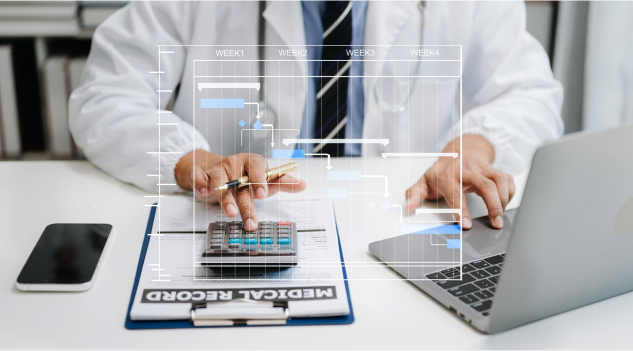In our previous blog, we uncovered the hidden costs of inefficient billing, shedding light on the myriad challenges healthcare practitioners face daily.
Today, we step into a new realm: “The Power of Data in Medical Billing.” Data is more than just numbers and statistics; it’s the key to unlocking billing excellence and transforming your practice. Here, we’ll explore the vital role that data plays in addressing crucial aspects such as claims denial rates, first-pass ratios, and accounts receivable outstanding.
The Impact of Data in Medical Billing
Inefficient billing practices can result in a multitude of issues, from claim denials to delayed payments. The power of data lies in its ability to not only identify these issues but also provide the means to resolve them. We find that many practices are not even aware of or tracking their own key metrics such as: claims first-pass ratio, claims denial rates and reasons, and account receivable aging. Let’s dive into some of these critical aspects where data can make a difference:
- Claims Denial Rates:
- First-Pass Ratios:
- Accounts Receivable (AR) Outstanding:
- Billing Process Efficiency:
One of the most significant challenges in medical billing is claim denials. According to Change Healthcare, denied claims averaged 10–13% of all submitted claims; 86% of these are potentially avoidable! Denied claims not only delay revenue but also require extensive resources to rectify. Data analytics can track and analyze denial rates, helping practices pinpoint recurring issues. Armed with this insight, you can proactively address root causes, reduce denials, and accelerate cash flow.
A high first-pass ratio is a strong indicator of billing efficiency. It measures the percentage of claims that are accepted by payers without the need for rework. The industry benchmark for this metric is a 90% first-pass ratio. Data-driven solutions can help you track and optimize your first-pass ratio, ensuring that your claims are accurate, compliant, and processed swiftly.
Timely collections are essential for maintaining a healthy cash flow. Average “days in AR” should be 30 days or less for a high-performing medical billing department.
Data analytics can provide visibility into your accounts receivable outstanding, allowing you to prioritize collection efforts effectively. You can identify aging accounts and implement strategies to recover outstanding payments more efficiently. Would you like a free no obligation assessment of your billing?
Data can also reveal bottlenecks and inefficiencies in your billing process. By analyzing workflow data, you can identify areas where automation and streamlining can reduce administrative burdens and speed up the billing cycle.
Data-driven medical billing processes like Emerald’s help with:
- Improved reimbursements Analyzing reimbursement trends can help practices negotiate better rates with payers, compensating for declining reimbursements.
- Improve Patient Estimations: Data analytics can provide accurate patient out-of-pocket cost estimates, reducing surprises and increasing payment collections.
- Adapt to Payer Changes: Real-time updates on payer regulations and automated compliance checks ensure claim submissions are in line with evolving rules.
- Reduce Provider Burnout: By automating billing processes and reducing claim denials, data-driven solutions alleviate administrative burdens and decrease burnout rates.
By embracing data-driven billing, practices can better navigate the shifting healthcare landscape, enhance patient financial experiences, and ultimately alleviate the stress on healthcare providers.
Real-Life Impact
Practices that chose Emerald typically struggled with a high claim denial rate, resulting in prolonged cash flow gaps and administrative headaches. By implementing data-driven solutions, we are able to identify common denial reasons, such as coding errors and missing documentation.
Benefiting from Emerald’s rigorous processes, most of our customers experience low 2-4% denials rates, leading to faster payments and a healthier bottom line.
Conclusion: Harnessing the Data Advantage
The power of data in medical billing is not just a buzzword; it’s a game-changer. By harnessing the insights provided by data analytics, you can optimize your billing processes, reduce administrative burdens, and ultimately improve profitability.
In our next blog, we will explore the critical role of accurate coding in medical billing, delving into the importance of precision and compliance. Stay tuned for “Navigating the Complex World of Coding,” where we’ll unravel the mysteries and unveil strategies for mastering this crucial aspect of billing excellence.
- Predictive Analytics: Anticipating disease outbreaks and patient needs.
- Personalized Medicine: Tailoring treatments based on individual genetic and health data.
- Improved Patient Outcomes: Identifying best practices and optimizing treatment protocols.
- Cost Reduction: Streamlining operations and eliminating inefficiencies.
- Public Health Monitoring: Tracking and managing public health issues in real-time.
- Predictive Analytics: Using data to forecast health trends and outcomes.
- Personalization: Customizing healthcare based on individual patient data.
- Prevention: Identifying risk factors and preventing diseases before they occur.
- Population Health: Managing and analyzing the health data of populations to improve public health.
- Performance: Enhancing healthcare delivery and operational efficiency through data-driven insights.
- Clinical Data: Patient health records, diagnostic test results, treatment plans, and clinical notes.
- Administrative Data: Billing and claims data, patient demographics, and hospital administrative records.
- Patient-Generated Data: Information collected directly from patients, such as through wearable devices or health surveys.
- Genomic Data: Genetic information used for personalized medicine and research.
- Pharmaceutical Data: Information on medication usage, efficacy, and side effects.
- Electronic Health Records (EHRs): Digital versions of patients' paper charts, capturing clinical and medical information.
- Medical Devices: Wearable technology and other medical devices that monitor and record health metrics.
- Surveys and Questionnaires: Collect self-reported data about patients' health and lifestyle.
- Claims Data: Information generated during the medical billing process.
- Laboratory and Diagnostic Tests: Results from blood tests, imaging studies, and other diagnostic procedures.
- Public Health Records: Health departments and agencies collect data for monitoring and managing public health.




